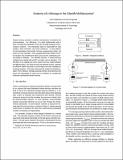Anatomy of a message in the Alewife multiprocessor
Author(s)
Kubiatowicz, John; Agarwal, Anant
DownloadAgarwal_Anatomy of.pdf (124.0Kb)
OPEN_ACCESS_POLICY
Open Access Policy
Creative Commons Attribution-Noncommercial-Share Alike
Terms of use
Metadata
Show full item recordAbstract
Shared-memory provides a uniform and attractive mechanism for communication. For efficiency, it is often implemented with a layer of interpretive hardware on top of a message-passing communications network. This interpretive layer is responsible for data location, data movement, and cache coherence. It uses patterns of communication that benefit common programming styles, but which are only heuristics. This suggests that certain styles of communication may benefit from direct access to the underlying communications substrate. The Alewife machine, a shared-memory multiprocessor being built at MIT, provides such an interface. The interface is an integral part of the shared memory implementation and affords direct, user-level access to the network queues, supports an efficient DMA mechanism, and includes fast trap handling for message reception. This paper discusses the design and implementation of the Alewife message-passing interface and addresses the issues and advantages of using such an interface to complement hardware-synthesized shared memory.
Date issued
2014Department
Massachusetts Institute of Technology. Laboratory for Computer ScienceJournal
ACM International Conference on Supercomputing 25th Anniversary Volume
Publisher
Association for Computing Machinery (ACM)
Citation
John Kubiatowicz and Anant Agarwal. 1993. Anatomy of a message in the Alewife multiprocessor. In ACM International Conference on Supercomputing 25th Anniversary Volume, Utpal Banerjee (Ed.). ACM, New York, NY, USA, 193-204.
Version: Author's final manuscript
ISBN
9781450328401